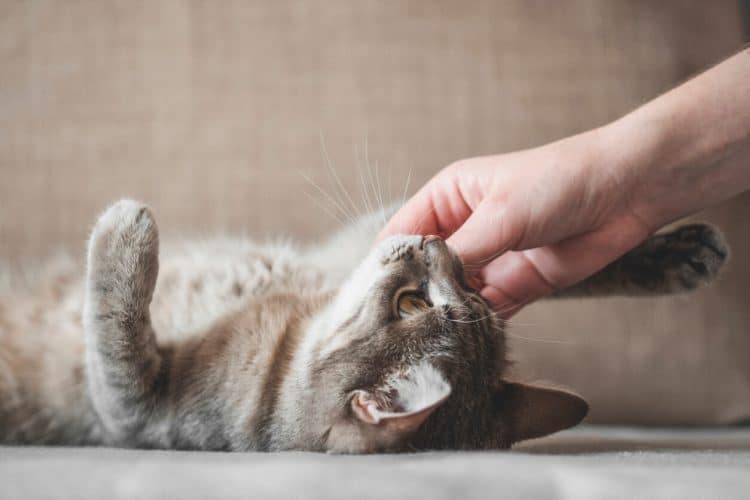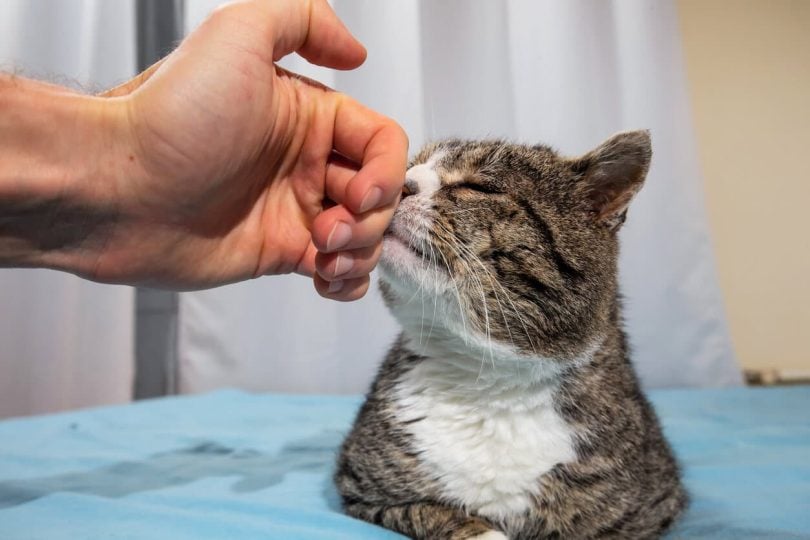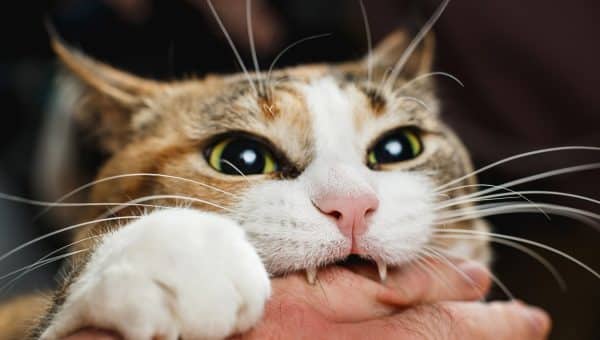- Not a substitute for professional veterinary help.
You might love being tickled or hate it, but you’re probably at least a little ticklish. Most people are—and many cats are ticklish, too, particularly in areas like their paws and stomach!
Humans can feel two forms of tickling: Gargalesis and knismesis. Gargalesis tickles make you giggle, and you can’t cause these tickles yourself. Knismesis tickles give you goosebumps, and they’re caused by light movement across the skin.
Experts believe cats only experience knismesis tickles, but they don’t know whether tickling may cause discomfort or pain for cats. “Knismesis may serve as a warning that something dangerous, like a parasitic tick, flea, or a spider, is crawling on the skin” says Stephen Quandt, Feline Training and Behavior Specialist and owner of Cat Behavior Help.
Thus, it’s important to avoid attributing human emotions to a cat’s response to being tickled, since they may perceive the sensation as a warning of danger—not a bonding experience, he says.
Before you try tickling your cat, read on to learn where cats are most ticklish, how to tell if your cat enjoys being tickled, and alternative ways to bond with your favorite feline.
Where Are Cats Most Ticklish?
The most ticklish spots on cats are areas with less fur, including their:
- Ears
- Nose
- Paw pads
Quandt adds that cats’ stomachs are typically more sensitive, too. “Cats are often sensitive to having their stomachs touched as this is where ticks might attach and spread disease or cause anemia in kittens. Knismesis may help them detect and remove invaders whenever possible,” he explains.
Sphynx cats and other nearly hairless breeds have more exposed skin than other breeds, so they may be more ticklish than other cats.
How Do I Know If My Cat Likes Being Tickled?
Tickling doesn’t always feel good to humans, and the same applies to your cat. That’s why it’s so important to observe and respect a cat’s body language, Quandt says.
Signs a cat enjoys a light, ticklish touch include:
- Purring
- Soft eye contact
- Pushing their body against your hand
- Perked-up and forward-facing ears
- A still or only slightly moving tail
“Tickling can be seen as a variation on petting, so it’s always a good idea to ask for consent when touching a cat (or a dog!),” Quandt adds. You can do this by extending your hand and letting your cat make the choice to engage.
Your cat may appreciate a gentle tickle under the chin, rather than in sensitive areas that may cause a creepy-crawly feeling, Quandt says.
Just keep in mind that they may react suddenly if they don’t enjoy the sensation.
Do cats laugh when you tickle them?
Your cat won’t laugh or smile when you tickle them, but they could very well start purring because they’re enjoying the attention.
It’s not fully understood why humans laugh when tickled. However, since human babies have a delayed laughter reaction to being tickled, this could happen as a conditioned response—similar to the way cats purr when people give them attention.
People didn’t teach cats how to purr or inspire the behavior directly. Still, cats probably expanded their use of purring in response to the way people react to this behavior, says Dr. Lindsay Butzer, small animal veterinarian and general practitioner at PetMeds.
Signs Your Cat Doesn’t Want To Be Touched Or Tickled
Some ticklish cats may not like being petted, while other cats have a low threshold for touch in general.
That’s what makes it so important to get your cat’s consent before you pet them and then pay attention to clues they want you to stop, such as:
- Moving away from your hand
- Rippling or twitching skin, including twitching of the ears
- Ears pointing back or pinned against the head
- Stiff body posture
- A thrashing tail
- Raised fur
- Dilated pupils
- Hissing, growling, or snarling
Since cats don’t experience the feel-good type of tickling (gargalesis), your touch may feel like a warning and they may try to shake you off like they would an insect, Quandt says.
How To Double-Check That Your Cat’s OK
Any time you’re gently tickling or petting a cat, take a break to check in for consent. “Consent implies that the individual has the right to say no,” says Joey Lusvardi, a Certified Cat Behavior Consultant and owner of Class Act Cats.
To ask a cat for consent to continue petting or to pet another area, offer them your hand or finger at a distance. If they choose to engage with you, they’re likely fine with continued petting.
“Cats may consent to you petting their cheeks, but not rubbing their bellies. Just because they’re OK with you petting them in one location doesn’t mean they’re OK with you petting them elsewhere,” Lusvardi adds.
Again, always watch for body language clues that your cat isn’t enjoying being tickled or petted. If they pull away or show other signs of discomfort, stop right away.
Other Forms of Stimulation A Ticklish Cat May Enjoy
If you really want to be tickled pink by your cat’s reaction, Quandt suggests providing engaging activities for your cat when they’d rather not be touched or tickled.
For example:
- Use puzzle feeders to engage their minds and simulate hunting behavior.
- Incorporate playtime with toys that bring out your cat’s hunting instincts, like wand toys.
- Provide high perches and cat trees to allow your cat to explore vertical territory.
- Add enriching smells, like catnip, to add variety to their lives.
- Set up window perches or bird videos for entertainment.
- Consider clicker training for mental stimulation.
- Train your cat to walk on a leash and harness or provide a catio for safe outdoor exploration.
- Vary the location of their food and water bowls to help them tune into their foraging instincts.






